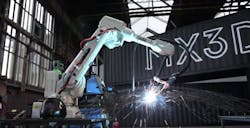A steel bridge in Amsterdam will be 3D printed
Dutch construction company Heijmans will be completing a steel bridge in the center of Amsterdam using what on paper seems like a futuristic method: with a 3D printer, robots, and steel.
The project was initiated by Dutch startup MX3D using a design by Joris Laarman, the company said in a statement.
To complete the bridge, MX3D will equip multi-axis industrial robots with 3D printing tools and develop software for the robots to print metals, plastics, and combinations of materials in a variety of formats.
“The new technique is cost-effective and scalable—more than current 3D printing methods—and offers creative robot production solutions for art, construction, and more,” the firm said.
"I strongly believe in the future of digital production and local production, in 'the new craft,'" said Laarman. "This bridge will show how 3D printing finally enters the world of large-scale, functional objects and sustainable materials while allowing unprecedented freedom of form."
Opening in September 2015 is a visitor center that will give the public access to the project’s progress. MX3D and the city of Amsterdam will announce the exact location soon.
